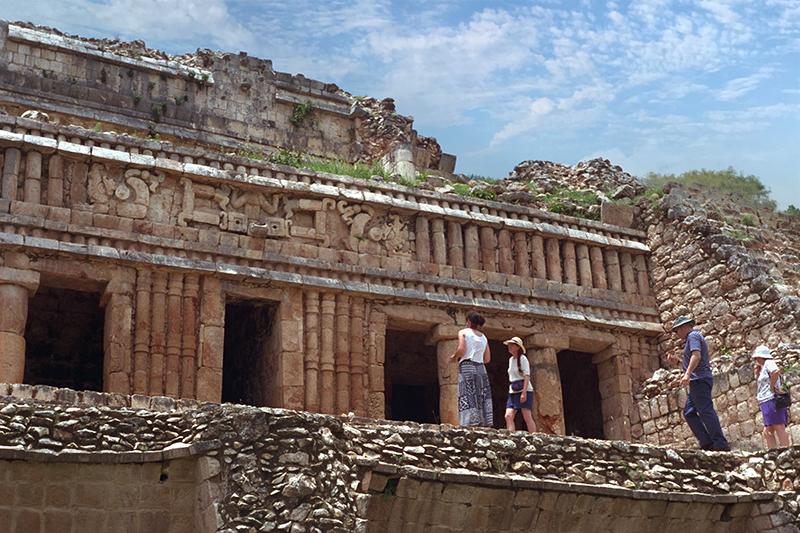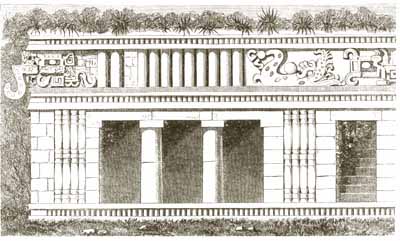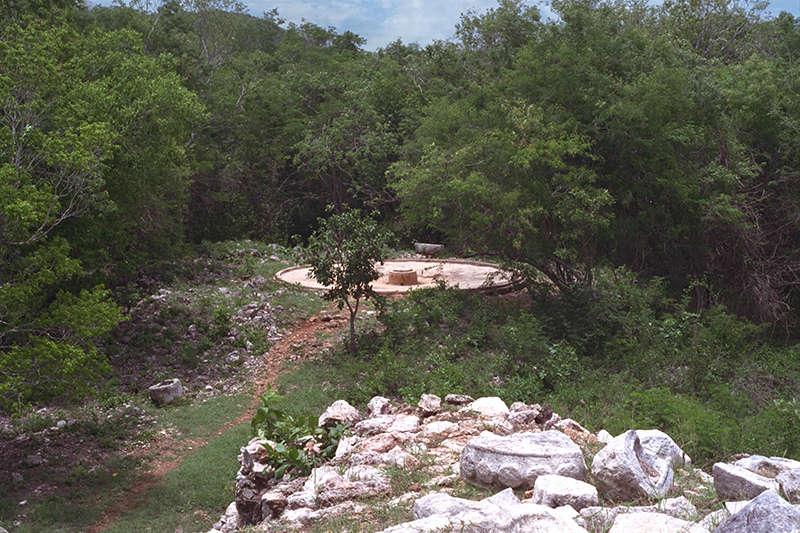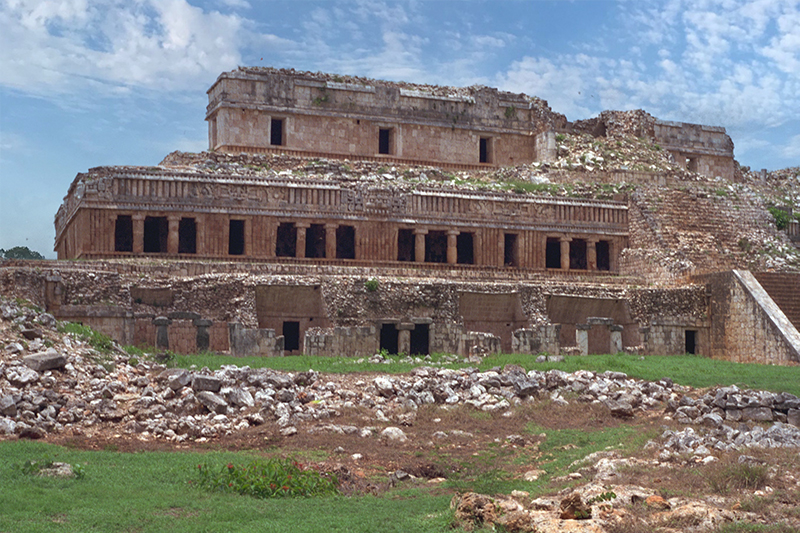

Our short Sayil reading list.
NEW! Subscribe to our free newsletter, MayaRuins Insights
Stephens and Catherwood visited "Zayi" during their 1841 expedition to the Yucatan. Stephens wrote: "After proceeding a mile and a half we saw at some distance before us a great tree-covered mound, which astonished us by its vast dimensions.
Our guides cut a path, and, clearing the branches overhead, we followed on horseback, dismounting at the foot of the Casa Grande.
It was by this name that the Indians called the immense pile of white stone buildings, which, buried in the depths of a great forest, added new desolation to the waste by which they were surrounded. We tied our horses, and worked our way along the front.
The trees were so close
that we could take in but a small portion of it at once...".
John Lloyd Stephens, Incidents of Travel in Central America, Chiapas & Yucatán, 1843

Continuing his description of their 1841 arrival, Stephens relates: "Without waiting to explore the rest of the ground...in a few minutes the stillness of ages was broken by the sharp ringing of the axe and the crash of falling trees.
With a strong force of Indians, we were able, in the course of the day, to lay bare the whole of the front.
Dr. Cabot did not arrive on the ground till late in the day, and, coming upon it suddenly from the woods, when there were no trees to obstruct the view, and its three great ranges and immense proportions were visible at once, considered it the grandest spectacle he had seen in the country."
Stephens, John Lloyd. Incidents of Travel in Yucatan. Illustrated by Frederick Catherwood. Dover Publications, Inc. New York 1963, vol. 2, p. 5-6


"The plate represents so much of the building as now remains and can be presented in a drawing. It has three stories or ranges, and in the centre is a grand staircase thirty-two feet wide, rising to the platform of the highest terrace.
This staircase, however, is in a ruinous condition, and, in fact, a mere mound, and all that part of the building on the right had fallen, and was so dilapidated that no intelligible drawing could be made of it; we did not even clear away the trees.
The engraving represents all that part which remains, being the half of the building on the left of the staircase."
Stephens, John Lloyd. Incidents of Travel in Yucatan. Illustrated by Frederick Catherwood. Dover Publications, Inc. New York 1963, vol. 2, p. 6


"Figure 1 represents the ground plan of the three ranges, and gives the dimensions of the terraces.
The north side of the second range has a curious and unaccountable feature. It is called the Casa Cerrada, or closed house, having ten doorways, all of which are blocked up inside with stone and mortar...
In front of several were piles of stones, which [the Indians] had worked out from the doorways, and under the lintels were holes, through which we were able to crawl inside; and here we found ourselves in apartments filled up (except so far as they had been emptied by the Indians) with solid masses of mortar and stone.
There were ten of these apartments in all, 220 feet long and ten feet deep, which being thus filled up, made the whole building a solid mass; and the strangest feature was that the filling up of the apartments must have been simultaneous with the erection of the buildings, for, as the filling-in rose above the tops of the doorways, the men who performed it never could have entered to their work through the doors. It must have been done as the walls were built, and the ceiling must have closed over a solid mass.
Why this was so constructed it was impossible to say, unless the solid mass was required for the support of the upper terrace and building; and if this was the case, it would seem to have been much easier to erect a solid structure at once, without any division into apartments."
Stephens, John Lloyd. Incidents of Travel in Yucatan. Illustrated by Frederick Catherwood. Dover Publications, Inc. New York 1963, vol. 2, pp. 8-10

"The exterior of the third and highest range was plain; that of the two other ranges had been elaborately ornamented."
Stephens, John Lloyd. Incidents of Travel in Yucatan. Illustrated by Frederick Catherwood. Dover Publications, Inc. New York 1963, vol. 2, p. 8

Images of the rain god adorn the palace of Labna. Chaac is everywhere apparent throughout the Puuc because of the uncertainly of the rains and their absolute necessity for survival.

Among designs common in other places is the figure of a man supporting himself on his hands, with his legs expanded in a curious rather than delicate attitude...
Stephens, John Lloyd. Incidents of Travel in Yucatan. Illustrated by Frederick Catherwood. Dover Publications, Inc. New York 1963, vol. 2, p. 8

Detail of the "Diving God" surrounded by monsters

"They believed that the ancient buildings were haunted, and every year music was heard sounding among the ruins."
Stephens, John Lloyd. Incidents of Travel in Yucatan. Illustrated by Frederick Catherwood. Dover Publications, Inc. New York 1963, vol. 2, p. 14

...and all that part of the building on the right had fallen, and was so dilapidated that no intelligible drawing could be made of it.
Stephens, John Lloyd. Incidents of Travel in Yucatan. Illustrated by Frederick Catherwood. Dover Publications, Inc. New York 1963, vol.2, p. 6


Catherwood's rendition of a portion of the elaborately ornamented facade on the second level.
However, it is interesting that Catherwood reversed the direction of the monster on the right side of his drawing.
Also note the staircase leading to the third level, which unfortunately was left out of my photo.
Stephens, John Lloyd. Incidents of Travel in Yucatan. Illustrated by Frederick Catherwood. Dover Publications, Inc. New York 1963, vol. 2, p. 9

A giant Chaac mask over the central doorway on the west side of the palace. The corner mask seen in the prior photo is visible to the right if this photo.


Stephens explored chultunes [underground cisterns] at several sites. He writes: "The opening was a circular hole, eighteen inches in diameter. The throat consisted of five layers of stones...about a yard deep, and the Indians lowered me down, without any obstruction, to the bottom.
It did not..require much time to explore this vault. It was clear of rubbish, perfect and entire in all its parts, without any symptoms of decay, and to all appearances, after the lapse of unknown years, fit for the uses to which it was originally applied.
Like the one on the terrace, it was dome-shaped, and the sides fell in a little toward the bottom, like a well-made haystack. The height was ten feet and six inches directly under the mouth, and it was seventeen feet six inches in diameter.
The walls and ceiling were plastered, still in a good state of preservation, and the floor was of hard mortar."
Stephens, John Lloyd. Incidents of Travel in Yucatan. Illustrated by Frederick Catherwood. Dover Publications, Inc. New York 1963, vol. 1, pp. 133-134

"The lowest of the three ranges is two hundred and sixty-five feet in front and one hundred and twenty in depth. It had sixteen doorways, opening into apartments of two chambers each. The whole front wall has fallen; the interiors are filled with fragments and rubbish..."
Stephens, John Lloyd. Incidents of Travel in Yucatan. Illustrated by Frederick Catherwood. Dover Publications, Inc. New York 1963, vol 2, p 6